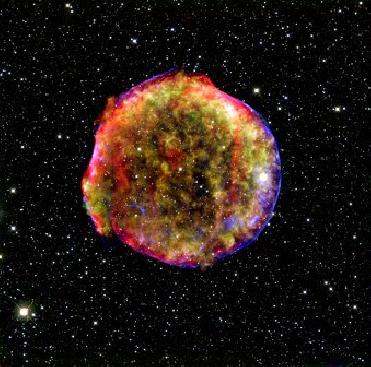
This composite image of the Tycho supernova remnant combines infrared and X-ray observations obtained with NASA's Spitzer and Chandra space observatories, and the Calar Alto observatory, Spain
LONDON (BNS): A team of astronomers has developed a new model which explains the formation of most youthful type Ia supernovae, according to a paper published in the Royal Astronomical Society.
The model, designed by the team led by Bo Wang from the Yunnan Observatory of the Chinese Academy of Sciences, shows how the transfer of material from a ‘helium star’ to a compact white dwarf companion causes cataclysmic events that take place early in the life of the galaxy they formed in.
Most type Ia supernovae are believed to occur when a white dwarf (the superdense remnant that is the end state of stars like the Sun) draws matter from a companion star orbiting close by.
When the white dwarf mass exceeds the so-called Chandrasekhar limit of 1.4 times the mass of the Sun, it eventually collapses and within a few seconds, undergoes a runaway nuclear fusion reaction, exploding and releasing vast amount of energy as a type Ia supernova. Due to their high and remarkably consistent luminosities, astronomers use these events as ‘distance indicators’ to measure distances to other galaxies.
Scientists have confirmed more and more type Ia supernovae, and found that about half of them explode less than 100 million years after their host galaxy’s main star formation period.
However, previous models for these systems did not predict that they could be this young. So, Dr. Wang and his team set out to solve this mystery.
Employing a stellar evolution computer code, the researchers performed calculations for about 2,600 binary systems consisting of a white dwarf and a helium star, a hot blue star which has a spectrum dominated by emission from helium.
They found that if the gravitational field of the white dwarf pulls material from a helium star and increases its mass beyond the Chandrasekhar limit, it will explode as a type Ia supernova within 100 million years of its formation.
The team now plans to model the properties of the companion helium stars at the moment of the supernova explosions, which could be verified by future observations.
According to team member Prof. Zhanwen Han, “Type Ia supernovae are a key tool to determine the scale of the Universe so we need to be sure of their properties. Our work shows that they can take place early on in the life of the galaxy they reside in.”
This composite image of the Tycho supernova remnant combines infrared and X-ray observations obtained with NASA's Spitzer and Chandra space observatories, and the Calar Alto observatory, Spain.
 Previous Article
Previous Article Next Article
Next Article













The Indian Air Force, in its flight trials evaluation report submitted before the Defence Ministry l..
view articleAn insight into the Medium Multi-Role Combat Aircraft competition...
view articleSky enthusiasts can now spot the International Space Station (ISS) commanded by Indian-American astr..
view article